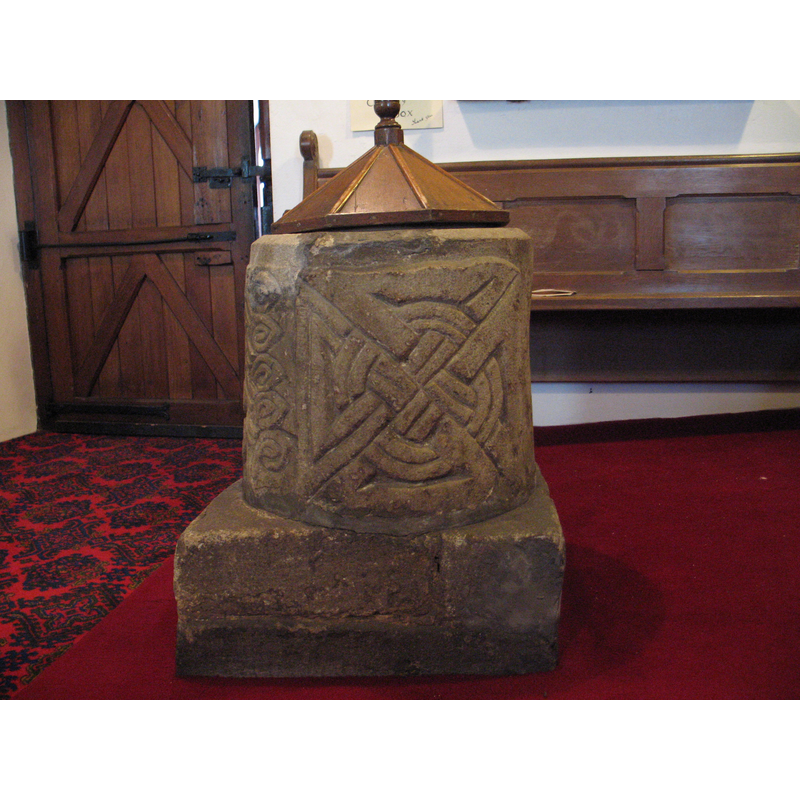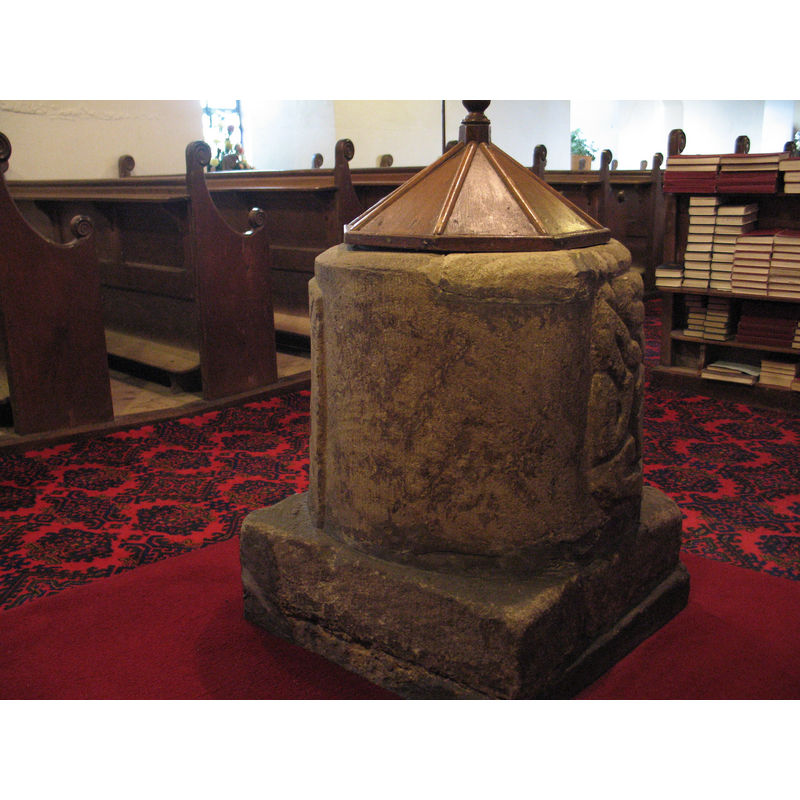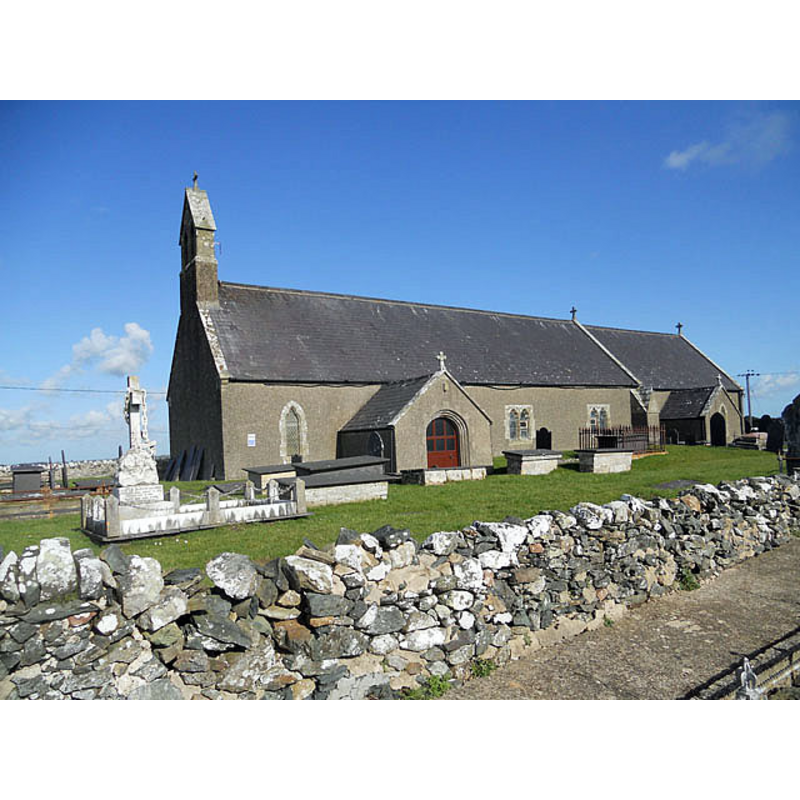Newborough / Llananno / Newborough St. Peter / Niwbwrch / Rhos Hir / Rhos Vair

Image copyright © Madeleine Gray, 2009
Image and permission to reproduce them received (email of 28 Nov. 2009)
Results: 10 records
B01: design element - patterns - interlace - knot
B02: design element - patterns - interlace - loop - continuous loop - 2-strand
B03: design element - patterns - interlace - ring-knot - with saltire
Scene Description: north side of the basin [cf. side C in Font notes]
Copyright Statement: Image copyright © Madeleine Gray, 2009
Image Source: digital photograph taken 20 November 2009 by Madeleine Gray [University of Wales, Newport/Prifysgol Cymru, Casnewydd]
Copyright Instructions: Image and permission to reproduce them received (email of 28 Nov. 2009)
B04: blank
view of basin - detail
view of basin - detail
view of basin - detail
view of church exterior - southwest view
view of font and cover
INFORMATION
FontID: 09110NEW
Object Type: Baptismal Font1
Church/Chapel: Parish Church of St. Peter / Eglwys St. Pedr
Church Patron Saints: St. Peter [formerly dedicated to St. Arno/Anno? / St. Mary?]
Country Name: Wales
Location: Anglesey, Gwynedd
Directions to Site: Located on A4080, across the Menai, 7 km WNW of Caernarfon, 20 km from Bangor
Historical Region: Hundred of Menai
Font Location in Church: Inside the church
Century and Period: 10th - 11th century / 12th century, Pre-Conquest? / Norman?
Cognate Fonts: In the same general shape as several other fonts in the area (e.g.: Cerrigceinwen, Llangristiolus, etc.) [cf. FontNotes]
Credit and Acknowledgements: We are grateful to Dr. Madeleine Gray, of the School of Education/Ysgol Addysg, University of Wales, Newport/Prifysgol Cymru, Casnewydd, for her information on, and photographs of this font
Font Notes:
Click to view
Lewis's Dictionary (1833) reports "a small church, dedicated to St. Mary, which stood at the head of the manor", and another in Llandwyn, a hamlet of Newborough: "Of the ancient church of Llanddwyn only the eastern gable, with some portion of the east window, can be seen : it was situated on a flat near the sea-shore, and was a fine structure, originally founded by St. Dwynwen, the tutelar saint of lovers, to whom it was dedicated, about the year 465". Lewis (ibid.) is not impressed by St. Peter's itself: "The church, dedicated to St. Peter, is a small edifice, possessing no claims to architectural description ; it stands on an eminence in a bleak and exposed situation", and mentions nothing further about it. Jones (1846a) dates the font to the 12th century. The National Gazetteer of 1868) reports "a curious font of the 12th century" in this church [NB: the Gazetteer notes also that the church was "dedicated to St. Arno or Anno, and subsequently to St. Peter"]. Described and illustrated in Nash-Williams (1950): "Truncated comical tub font, with chamfered rim [...]. Gritstone. Decorated around the outer wall with three raised square panels containing deeply-cut designs: (a)plain (partly doubled-beaded) cruciform interlaced knot formed of four conjoined triquetras (R.A.733); (b)double vertical row of debased double-beaded loop-pattern (based on R.A.549) [...]; (c)conventional cruciform ring-knot (R.A.724, with ring). The back is plain. 12th century. Inside parish church [...]." Noted in Lewis' Dictionary edition of 1849: "A relic of a previous church is still preserved, in the font; this us probably of the twelfth century, but it has been defaced by later workmen, and has received successive coats of whitewash." In Edwards (1986) with 12th-century date. Noted and illustrated in Thurlby (2006) with references to the fonts at Cerrigceinwen and Trefdraeth and, more remotely, to those at Heneglwys and Llanbeulan, all of them in the Anglesey area, and probably dating from the 12th century. Noted and illustrated in Pritchard (2009) [NB: in a communication from Pritchard to Madelaine Gray, passed on to BSI, she writes: "Newborough - this is unlikely to be Romanesque. I have dated it as earlier on local & regional sculptural parallels. Most likely late C10th- early C11th - making it very early! Of similar date are two other Anglesey Fonts. The blank face/panel. Is fairly common. the most obvious reason being the intended loaction on the font. why decorate an area which will not be seen as it is against a wall? I have heard other suggestions, all of which sound more interesting, but none of which have any supporting evidence.."
COORDINATES
Church Latitude & Longitude Decimal: 53.162212, -4.364771
Church Latitude & Longitude DMS: 53° 9′ 43.96″ N, 4° 21′ 53.18″ W
UTM: 30U 408756 5891185
MEDIUM AND MEASUREMENTS
Material: stone, sandstone (coarse)
Number of Pieces: one
Font Shape: tub-shaped (round)
Basin Interior Shape: round
Basin Exterior Shape: round
Diameter (includes rim): 50 cm*
Font Height (less Plinth): 46.25 cm*
Square Base Dimensions: 57.5 cm [*diam.]
Notes on Measurements: * [In Nash-Williams (1950: 65) as: 23" diam. at the bottom; 20" at top; 18 1/2" h.]
LID INFORMATION
Date: 19th-century?
Material: wood, oak?
Apparatus: no
Notes: low pyramid of octagonal shape, with raised arrises and finial; modern?
REFERENCES
The National Gazetteer: a Topographical Dictionary of the British Isles, London: Virtue & Co., 1868
The Visual Culture of Wales = Diwylliant gweledol Cymru, Cardiff: University of Wales Press, 1998-2003
Edwards, N., "Anglesey in the Early Middle Ages: the Archaeological Evidence", 19--41, Anglesey Antiquarian Society and Field Club Transactions, 1986
Great Britain. Royal Commission on Ancient Monuments and Constructions in Wales and Monmouthshire, An Inventory of the Ancient Monuments in Wales and Monmouthsire, London: H.M. Stationary Office, 1911-1925
Jones, H. Longueville, "Nona Mediaeva No. IV", 1, Archaeologia Cambrensis, 1846a, pp. 425-436; p. 427
Lewis, Samuel, A Topographical Dictionary of England, Comprising the Several Counties, Cities, Boroughs, Corporate and Market Towns, Parishes, Chapelries, and Townships, and the Islands of Guernsy, Jersey, and Man, with Historical and Statistical Descriptions [...], London: S. Lewis, 1831
Lewis, Samuel, A Topographical Dictionary of Wales, Comprising the Several Counties, Cities, Boroughs, Corporate and Market Towns, Parishes, Chapelries, and Townships, with Historical and Statistical Descriptions [...], London: S. Lewis, 1833
Nash-Williams, Victor Erle, The Early Christian Monuments of Wales, Cardiff: University of Wales Press, 1950
Pritchard, Aimee, "The origins of ecclesiastical stone architecture in Wales", The Early archaeology of the Early-Medieval Celtic churches, Leeds: Maney, 2009
Thurlby, Malcolm, Romanesque architecture and sculpture in Wales, Little Logaston, Woonton, Almeley, Herts.: Logaston Press, 2006
![south side of the basin [cf. side A in Font notes]](/static-50478a99ec6f36a15d6234548c59f63da52304e5/compressed/1091129017_compressed.png)
![east side of the basin [cf. side B in Font notes]](/static-50478a99ec6f36a15d6234548c59f63da52304e5/compressed/1091129018_compressed.png)


